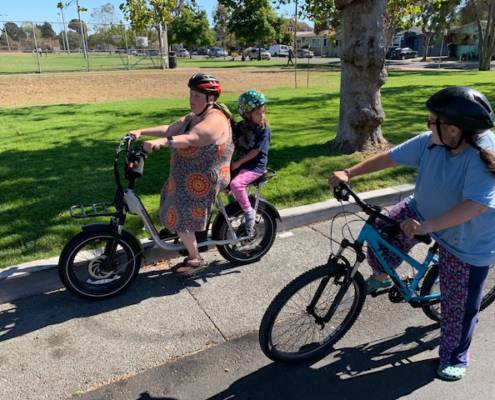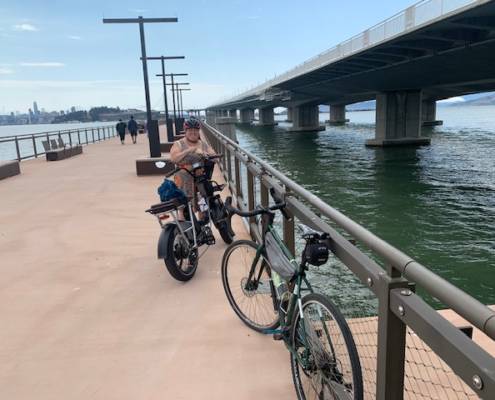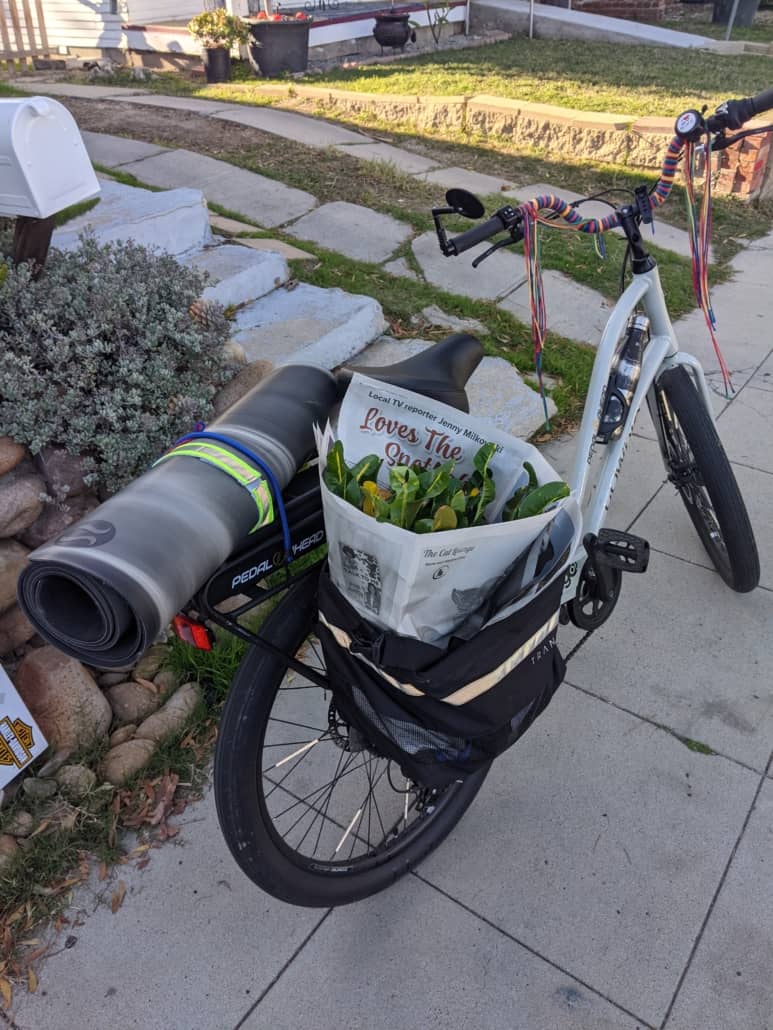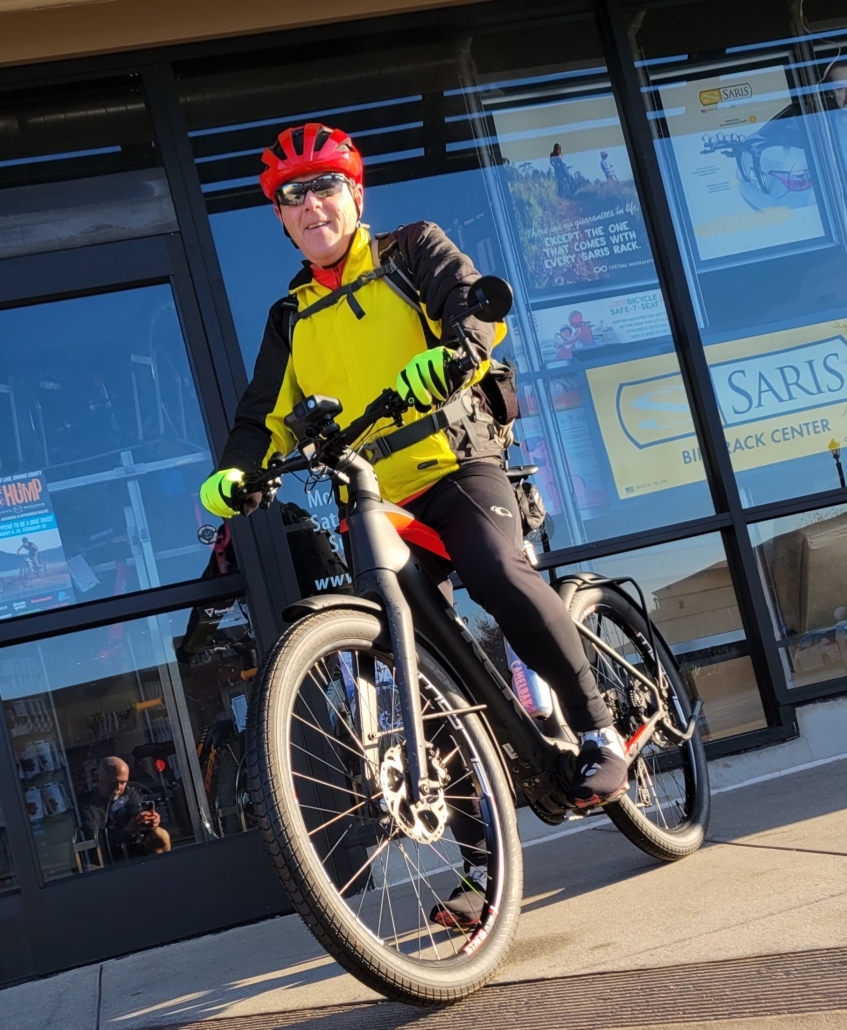E-Bike Purchase Incentives FAQs
California’s E-Bike Purchase Incentive Project is distributing vouchers in a series of application windows. We will post upcoming application windows here and on our e-bike campaign page.
Pedal Ahead, the administrator of this program for the California Air Resources Board (CARB), has published its own FAQs.
Note: We update these FAQs as new information becomes available. This post was originally published on October 19, 2022, and last updated May 9, 2025
The official website for California’s E-Bike Incentive Project is live at ebikeincentives.org. You can get more information about how to apply for an incentive at that site, and bicycle manufacturers and retailers can sign up to participate.
Important note and we can’t emphasize this enough: There are not enough e-bike vouchers for everyone who qualifies and wants a bike. Think of it like the lottery — some people will succeed in getting vouchers, but many more will not. If you meet the program requirements, you still have to get in line during an application window and submit an application — and not everyone who gets in line will make it through the application process. The program has a limited scope and budget that can’t meet the tremendous demand.
CalBike continues to advocate for additional funding for this hugely popular program.
TL;DR version:
- The next application window will be May 29, 2025.
- The program began distributing vouchers in December 2024. The April 29, 2025, application window was canceled and rescheduled due to technical issues that kept some people from accessing the waiting room.
- More vouchers will be released in subsequent application windows.
- The program is limited to California residents with income at or below 300% of the federal poverty level.
- Applicants must be at least 18.
- The voucher amount will be $1,750, with $250 additional for people below 225% FPL or living in a disadvantaged census tract.
- Incentives are limited to one per person. There is no limit per household.
- Demand continues to grow for this program, and there are a limited number of vouchers. Check out one of the many local e-bike incentive programs for more options. Visit our e-bike page for a full list.
What is California’s E-Bike Incentive Project?
The E-Bike Incentives Project is a program to provide vouchers to California residents to help them afford an e-bike. CalBike advocated for the budget allocation, which passed in 2021 and funds the pilot project. CARB has allocated additional funds for a total of $31 million, which will fund approximately 15,000 vouchers.
The California legislature hasn’t allocated ongoing funding for the program past the pilot, but CalBike will advocate for continued funding, and CARB appears committed to including e-bikes in its clean vehicle incentive programs.
When can I apply for a California e-bike incentive?
Vouchers will be released during limited application windows. We will post the dates of new application windows as soon as we know them. CARB usually announces application dates two to three weeks ahead of time.
I tried to apply for a voucher in the past. Did the system save my information?
No. You must start your application from scratch in each application window. Demand for this program is very high, so the administrator’s systems are unable to save information from people who haven’t yet been through the whole process.
What is the process to apply for a voucher from California’s statewide e-bike incentives program?
Be sure you have the required documentation and that you meet the income qualifications. The online waiting room will be open for an hour before the application window opens on Thursday, May 29, 2025, allowing everyone time to log on.
Important: Once you’re in the waiting room, do not close your browser window. Navigate to that window a few minutes before the deadline and do not leave.
Everyone who’s in the waiting room at the end of the hour during the next application window will receive a randomly assigned number generated by a software program. That designates your place in line.
This application window will distribute 1,000 vouchers. If you’re assigned a number of 2,000 or below, stay in line. Even if you’re over 1,000, you might get through if people ahead of you drop off. Once the required applications are completed, the portal will close.
If you apply for a voucher, the administrator will confirm your eligibility. Once your application is accepted, you’ll receive a code you can take to a participating e-bike retailer or online store. This process can take several weeks, so please be patient. The amount of your voucher will be applied to your purchase, which can include gear such as racks, a lock, or a helmet, in addition to the bike.
You can find more information about the application process in the implementation manual and you can also watch a webinar CalBike hosted to answer questions about the process.
What if I can’t apply online?
People who aren’t able to apply through the online portal may request a paper application from the administrator. Requests for paper applications will be randomized using the same system as the online portal, so people who want vouchers have the same chance of being able to apply by either method.
I meet all the qualifications to get a voucher. Why can’t I get one?
We have heard from many people who are understandably disappointed and frustrated that they weren’t able to submit their application for an e-bike incentive during the most recent application window.
The reality is that CARB’s E-Bike Incentive Project is not like many of the other programs that benefit low-income Californians, where applicants who meet the program criteria are guaranteed the benefit. The e-bike program has limited funding and a limited number of vouchers to distribute. Applications are taken during designated windows on a first-come, first-served basis and not everyone will be able to apply for a voucher. For context: during the first application window in December of 2024, nearly 100,000 people got in line for 1,500 vouchers.
CalBike continues to advocate for more funding for this program, but many people who want vouchers will not get them. However, there are many local e-bike incentive programs where you might have a better chance of getting assistance to buy an electric bike.
I signed up on the mailing list. Am I in line to get a voucher?
No. The only way to apply for an e-bike voucher is by going to https://www.ebikeincentives.org/apply/ during a designated application period. There is no waitlist for this program.
Joining the mailing list for the E-Bike Incentive Project or CalBike’s mailing list will give you timely updates on the program, but it has no impact on your application status.
Will there be more e-bike incentives, or is this a one-time program?
The current plan envisions several application windows to distribute the $31 million currently available.
How long does it take to apply for an e-bike incentive?
The online application process takes about 20-30 minutes. In addition, you might have to wait in line to access the application portal. During the first application window, people waited in line for up to 45 minutes. Being in line doesn’t guarantee that you’ll get to submit an application.
If you do get to submit your application, you can make the process faster by:
- Having all your paperwork handy. You can find a list of documents to prove eligibility here. Have scans of the documents you’re using to prove eligibility or take a photo with your phone.
- Watch the required e-bike safety and climate impact videos ahead of time. The safety video is 12 minutes long and the climate video is five minutes. Pre-watching will allow you to simply check those boxes and complete your application in about 10 minutes.
You don’t need to know what bike you want to purchase before you apply for the voucher. You will have 45 days to select and purchase your bike. If you need more time, you can request a 45-day extension.
I submitted an application. When will I get my voucher?
People who submitted applications should allow up to 60 days to receive their vouchers. Once your application is approved, you will receive an email with a voucher code you can take to a bike shop or online retailer to apply to the purchase of an e-bike.
The administrator will contact you if your application is missing any items needed for approval. If that happens, you must respond within 14 days to preserve your application reservation.
What are the requirements to apply for an e-bike incentive?
You will have to prove income eligibility and California residency.
Other requirements:
- Be at least 18 years old
- Purchase the bike within 45 days of incentive award with the option to extend for an additional 45 days
- Own the bike for one year
- Take a 12-minute bike safety education class online
Can more than one person in the same household apply for an e-bike voucher?
Yes.
Individuals can only get one voucher each, but there is no limit to how many people from the same household can apply as long as each person qualifies.
Who qualifies for the California e-bike incentive program?
Eligibility for the pilot program will be limited to people whose income is less than 300% of the federal poverty level. That means the income caps (based on 2024 FPL guidelines) would be:
- Individual: $45,180
- Family of 2: $61,320
- Family of 3: $77,460
- Family of 4: $93,600
- Family of 5: $109,740
How much will the California e-bike incentives be?
The base incentive will be $1,750 for all types of e-bikes. The program will offer an additional $250 to people living below 225% of the federal poverty level or living in a disadvantaged community. The maximum incentive is $2,000.
Can I stack the California e-bike incentive with other e-bike incentives or rebates?
Yes.
If you qualify for a California voucher and an e-bike incentive from a local government, utility, transportation agency, or other entity, you may use both incentives toward the purchase of the same e-bike. This is called stacking. Some local programs are planning to work in tandem with the statewide incentives while others might not allow stacking; ask your local provider for more information.
What kinds of bikes qualify for incentives?
You can use the incentive to buy any type of e-bike, including a folding bike, cargo bike, or adaptive bike. All three classes of e-bikes will be eligible for the program. However, you will need to purchase from a list of approved e-bike models. You must purchase a bike with UL or EN safety certification.
E-bikes are grouped into three classes:
- Class 1: pedal assist only, 20 mph speed limited — will qualify for the program
- Class 2: pedal assist or throttle, 20 mph speed limited — will qualify for the program
- Class 3: pedal assist only, 28 mph speed limited, helmets required, must be 16 or older to operate — likely to qualify for the program
Note: Only bicycles that include pedals, fall into one of these three classifications, and are offered by an approved retailer qualify for the incentive program. Other forms of electric mobility, such as scooters and mopeds, are not included.
Why isn’t the e-bike model I want on the approved list?
The list of approved e-bike models is not a definitive list of all e-bikes that might qualify for the California program. A manufacturer or retailer must apply to have a model added to the list. Further, not all e-bike brands meet the requirement to have a business location in California.
If you want to see a particular e-bike model added to the list, contact the manufacturer or a local retailer that carries it and ask them to apply to the program. The incentive program continues to add new e-bike models to the list.
Where can I buy an e-bike with a CARB incentive?
The program administrator has a list of qualifying bike retailers. You can buy from a bike shop or order an e-bike online. All e-bikes in the program must come fully assembled, you online retailers must provide assembly.
Do I have to know what bike I want before I apply for an incentive?
No. People who receive vouchers have 45 days to buy a bike. If you can’t make the purchase in that time, you can apply for an extension and get an additional 45 days. You must request the extension — it isn’t automatic.
Can I buy an e-bike online with a voucher?
Yes. The list of qualifying bike retailers includes online e-bike retailers.
However, we recommend visiting a bike shop and test-riding e-bikes if possible. All bikes are not the same. It’s important to get a bike with a frame that fits you and that you feel comfortable riding. A bike shop can help you with this.
What if I have to return my bike?
You are allowed to exchange a bicycle bought with an e-bike incentive. However, the voucher doesn’t cover the cost of return shipping for bikes purchased online. That’s why we recommend test-riding bikes before you make a purchase, if at all possible.
What qualifies as an adaptive bike?
CARB wants to keep the definition of adaptive bike as inclusive as possible. The category will most likely include tricycles and bikes modified for people with disabilities.
Can I use an e-bike incentive to buy a conversion kit?
No. A conversion kit allows you to add aftermarket electric power to a standard bike frame. Conversion kits are not eligible for incentives.
Can I get a rebate on an e-bike I already purchased?
No. The Electric Bicycle Incentives Project is not a rebate program. You need to apply and get approved before you purchase a bike in order to use the incentive.
If you recently bought an e-bike, you might qualify for a rebate from a local program such as 511ContraCosta. Check the list on our e-bike page and ask your local utility about rebates. In addition, if the E-BIKE Act passes Congress, you might be eligible for a federal tax credit.
Can I buy bike accessories to go with my bike?
Yes. If you are awarded an incentive through the California program and your bike purchase, including sales tax, is less than the amount of your voucher, you can buy gear for your ride with the remaining balance. Approved purchases include racks, helmets, reflective vests, and locks.
If I don’t get a voucher in December, when can I try again?
CARB has not set a date for the next round of e-bike incentives. We will let you know as soon as we have that information.
Can I get an e-bike voucher from CalBike?
No.
CalBike is not administering the e-bike incentives program. Our role is one of advocacy. We advocated for the creation of this purchase incentive, and we will continue to push for an expanded budget to support the program. CalBike also shares critical information about the program via our e-bike newsletter, and we help our member’s voices be heard so that the program better serves the people who need it most. CalBike does not process or distribute incentives.
CARB will manage the incentive distribution process through its third-party administrator starting in 2023. We will share information about how to apply once it’s available, but CalBike won’t be involved in processing applications or awarding e-bike incentive vouchers.
Where else can I get assistance to buy an e-bike in California?
The E-Bike Incentives Project is California’s first statewide e-bike voucher program. However, there are many regional and local programs where you might be able to get funding to help you buy an e-bike now.
SB 400, which CalBike helped pass in 2019, added an e-bike benefit to the Clean Cars for All program, which aims to take polluting cars off the road. If you have a qualifying car to turn in, incentives can be as high as $9,500, and you can use the funds to buy e-bikes and bike accessories for multiple family members. However, this program is administered by regional air quality management districts, and not all districts have added the e-bike benefit. We spoke to people who got this voucher in the Bay Area and Southern California to give you an idea of the process. Find out more details about the Bay Area program on this handy reference page.
In addition, there are numerous local programs through nonprofit organizations, utilities, and other entities. You can find many California programs on this list of global e-bike incentive programs.
Why can’t I get an incentive to buy a non-electric bike?
Excellent question. The current program covers only electric bike purchases, not standard or acoustic bikes. Electric bikes tend to be significantly more expensive than traditional bikes, so a purchase incentive may be the only way for many people to afford one. In addition, many people who don’t feel comfortable riding a standard bike because of age, health issues, the need to carry passengers or cargo, etc., may replace car trips with bike trips on an electric bike.
However, the classic bicycle is incredibly energy-efficient and elegant transportation, and some places do offer incentives to help residents buy non-motorized bicycles. For example, the French government is offering 400 Euros to citizens who trade their cars for a bike or e-bike. CalBike would love to see a program like this in California, and we will continue to explore ways to encourage more people to choose the joy of riding a bike.
How do I purchase a bike with an incentive?
The statewide incentive will be a point-of-sale benefit. Once you pick out a bike from a qualifying retailer, the incentive amount will be applied when you make the purchase. You don’t have to put out that money up front and get reimbursed.
I’m an e-bike retailer or manufacturer. How can I participate in the program?
Retailers can apply online through the program website. Qualifying retailers must have some kind of physical presence in California (a shop, office, or manufacturing facility), even if you sell your bikes exclusively online, and can only sell eligible models through the program. It’s not too late for retailers to participate.
Manufacturers with e-bike models that meet the program’s specifications can also get their bikes added to the list of eligible bikes. Please contact the administrator for information on how to apply.
Is California’s statewide program an expansion of the San Diego e-bike program?
No. Some press reports stated that California’s statewide purchase incentive was an expansion of a similar program in San Diego. This is incorrect.
CARB chose Pedal Ahead, an organization that runs an e-bike program in San Diego, to administer the statewide program. However, the CARB purchase incentives pilot will have rules and parameters determined by CARB in conjunction with input from advocates and the public. The statewide program is separate from and different from the San Diego program.
How do I get more information about the e-bike incentive program?
Have we mentioned that CalBike has an e-bike incentives interest list? Use the form below to add your name, and we’ll send periodic updates as we get more information, including letting you know when you can apply.
You can also sign up for CARB’s e-bike email list to get information directly from CARB or sign up for the E-Bike Incentives Project email list.







